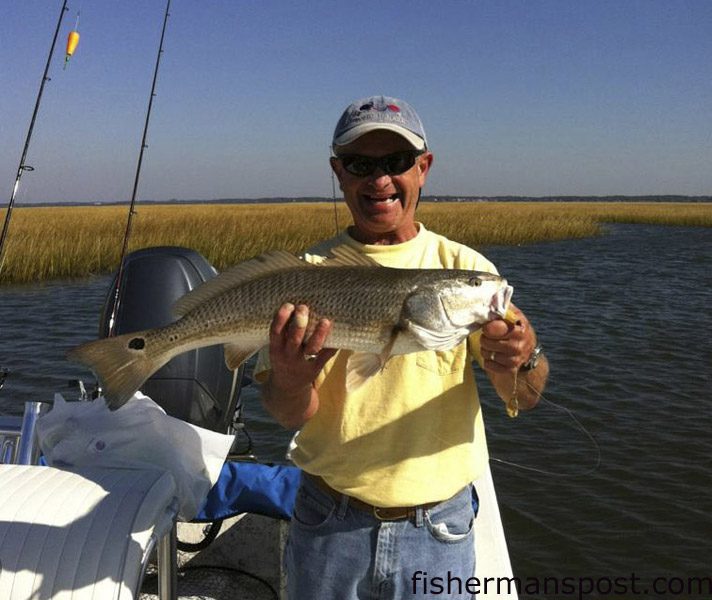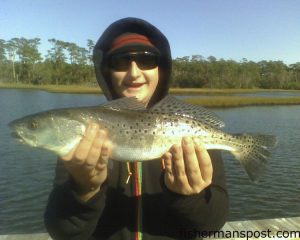Morehead City December 15, 2011

Pete Avery, of Wilmington, with a 27" red drum that bit a Redfish Magic spinnerbait in the Haystacks while he was fishing with Jack Richardson and Julian Vainwright.
Tim, of Chasin’ Tails Outdoors, reports that there are still some speckled trout and puppy drum feeding in the Haystacks marshes, though the fishing there will likely slow down as the water temperature drops. More specks and a few pups have been feeding around the rock jetties at Radio Island, Fort Macon, Shackleford Banks, and Cape Lookout. Slocum Creek has also been producing some solid speckled trout action lately. Live shrimp, Gulp baits, and MirrOlures have been producing most of the trout bites. The trout fishing should remain good into January or later barring any severe cold snaps.
Sea mullet and some gray trout are feeding in Beaufort Inlet and likely around the railroad tracks. Spec rigs tipped with shrimp will attract plenty of attention from both bottom feeders.
Pufferfish are feeding inshore and in the surf, and anglers should be able to load up on the tasty fish on bottom rigs baited with shrimp.
Surf casters are finding some action with speckled trout, puppy drum, black drum, and sheepshead around the Fort Macon rocks. Live shrimp will tempt bites from all four.
Trout and puppy drum are also feeding in the sloughs along the beachfront at Atlantic Beach and Shackleford, and soft plastics or MirrOlures will tempt both to bite.
Offshore, anglers bottom fishing at structure in the 18-20 mile range are connecting with some gag grouper and flounder in between the abundant (and closed to harvest) black sea bass. Bucktails tipped with Gulp or natural baits, and squid, cigar minnows, and cut baits on bottom rigs, will tempt bites from all the bottom dwellers.

Rick Best, of Newport, NC, captured the lead in the Chasin' Tails Speckled Trout Challenge--an 8.58 lb. fish that bit a live shrimp at the Cape Lookout jetty.
Blue water trollers are still finding solid wahoo fishing when they can make the run to the Gulf Stream. Ballyhoo rigged under skirted lures (especially in dark hues like purple/black) are difficult for the ‘hoos to turn down. Plenty of blackfin tuna are feeding around offshore structure like the Big Rock. Smaller ballyhoo (or lures like cedar plugs) will tempt bites from the blackfins.
A few rumors of bluefin tuna sightings have already come in, and anglers are hoping to see decent numbers show up off Morehead this winter. When and if they do, trolling large “horse” ballyhoo on the surface and deep behind planers will tempt the big tunas to bite.
Paul, of Freeman’s Discount Tackle, reports that speckled trout are feeding all over the area. Big numbers of trout (though many undersized fish) are holding around the Radio Island jetties and other hard structure inshore. Gulp baits will produce fast action with these smaller trout.
A better class of specks (18-20”) have been feeding around the Fort Macon rocks, and live mud minnows are fooling the larger fish.
The Haystacks, North River, Wards Creek, and Cape Lookout rock jetty have all also been producing solid trout action lately.
Specks and a few puppy drum are feeding in the surf as well. Casting soft plastic baits or MirrOlures in beachfront sloughs is the way to connect with the specks in the breakers.
The area’s trout fishing should remain good through January and possibly into February, but fishing extremely slowly is vital to be successful as the water gets colder.
Tautog have begun to show up around the port wall and other inshore and nearshore structure, and they should be around for months to come. Bottom fishing with clams will produce action with the ‘togs.

Will Cates, of Durham, NC, with his first speckled trout, caught in Spooner's Creek on a live shrimp while he was fishing with his dad.
Charlie, of Old Core Sound Guide Service, reports that the speckled trout action is excellent around the Cape Lookout jetty and in Core Sound and the backwaters around Harkers Island. Night fishing has been producing the best action at the jetty (with most fish 2-4 lbs.), and it should remain consistent for another month at least (and the fish get larger as the water gets cooler). Working MirrOlures around the rocks has been producing the majority of the fish.
Inshore, searching for schools of fish from a tower boat then wading to cast to the fish has been the most effective technique lately. Suspending MirrOlures are better than the faster sinking models for the fish in the sound.
Pete, of Energizer Charters, reports that the wahoo bite has been a bit slower lately, but boats running to the Gulf Stream have been connecting with good numbers of blackfin tuna. Ballyhoo under skirted trolling lures will tempt bites from the wahoo and tunas.





